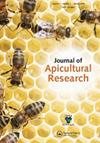First physicochemical analysis of stingless bee honey from Uganda
IF 1.8
4区 农林科学
Q2 ENTOMOLOGY
引用次数: 1
Abstract
Abstract Following years of its exploitation from only wild colonies, the stingless bee (Meliponula bocandei Spinola, 1853) was recently domesticated in Uganda. Products currently harvested by the beekeepers are honey and propolis. Studies from other countries have shown that stingless bees produce honey that is distinct in physicochemical properties. Therefore, in an effort to lay a foundation for the development of quality standards for stingless bee honey in Uganda, we collected M. bocandei honey from the Western Highlands and Lake Victoria Crescent agroecological zones. A selected set of physicochemical properties (moisture content, viscosity, water activity, electrical conductivity and HMF) of the honey were determined. Results reveal the following means of the physicochemical properties: moisture content (26.45 ± 3.9%), viscosity (38.32 ± 2.25 Pa.s), water activity (0.71 ± 0.04%), electrical conductivity (0.229 ± 86.91 mS/cm), pH (4.15 ± 0.68), and HMF (5.42 ± 4.78 mg kg−1), The low mean HMF reveals that stingless bee honey from these two agroecological zones is of good quality. Overall, the mean values of the physicochemical parameters measured are within the figures in the East African Community standards for stingless bee honey. We recommend investigations to establish the diversity of forage plant resources used by the stingless bee M. bocandei in order to boost meliponiculture.乌干达无刺蜜蜂蜂蜜的首次理化分析
无刺蜜蜂(Meliponula bocandei Spinola, 1853)经过多年的野生开发,最近在乌干达被驯化。目前养蜂人收获的产品是蜂蜜和蜂胶。其他国家的研究表明,无刺蜜蜂生产的蜂蜜在物理化学性质上是独特的。因此,为了为乌干达无刺蜂蜂蜜质量标准的制定奠定基础,我们采集了西部高地和维多利亚月牙湖农业生态区的M. bocandei蜂蜜。选择了一组物理化学性质(水分含量,粘度,水活度,电导率和HMF)的蜂蜜进行了测定。结果表明,两农业生态区无刺蜂蜂蜜的理化性质平均值为:水分含量(26.45±3.9%)、粘度(38.32±2.25 Pa.s)、水活度(0.71±0.04%)、电导率(0.229±86.91 mS/cm)、pH值(4.15±0.68)和HMF(5.42±4.78 mg kg - 1), HMF平均值较低,表明两农业生态区无刺蜂蜂蜜质量较好。总的来说,测量的物理化学参数的平均值在东非共同体无刺蜜蜂蜂蜜标准的数字之内。我们建议进行调查,以确定无刺蜜蜂所利用的饲料植物资源的多样性,以促进meliponulture。
本文章由计算机程序翻译,如有差异,请以英文原文为准。
求助全文
约1分钟内获得全文
求助全文
来源期刊
CiteScore
4.80
自引率
10.50%
发文量
111
审稿时长
6-12 weeks
期刊介绍:
The Journal of Apicultural Research is a refereed scientific journal dedicated to bringing the best research on bees. The Journal of Apicultural Research publishes original research articles, original theoretical papers, notes, comments and authoritative reviews on scientific aspects of the biology, ecology, natural history, conservation and culture of all types of bee (superfamily Apoidea).

 求助内容:
求助内容: 应助结果提醒方式:
应助结果提醒方式:


